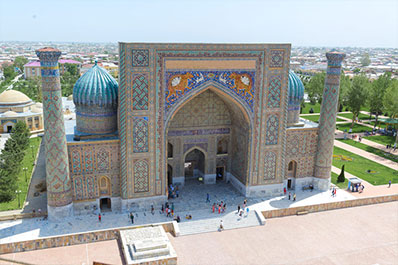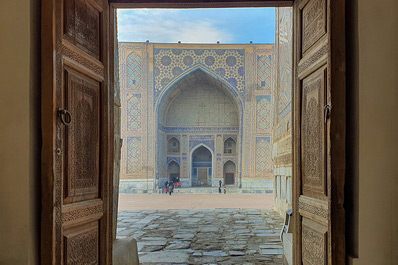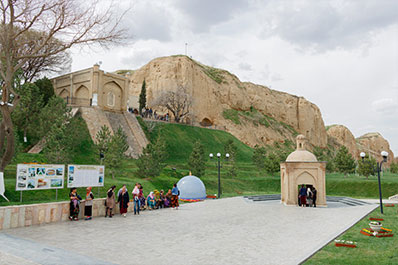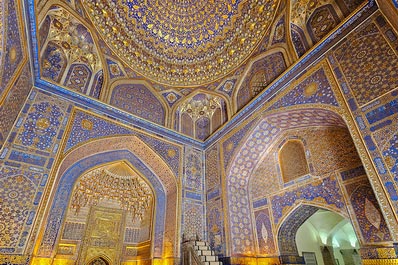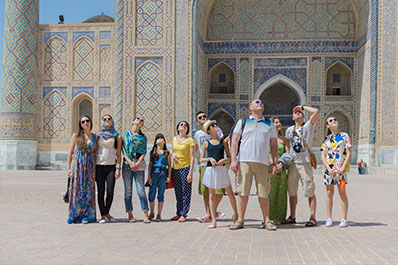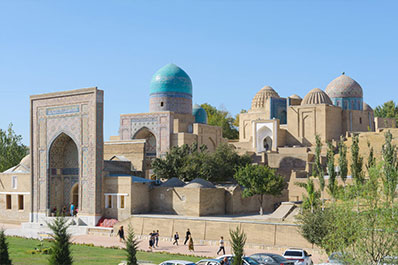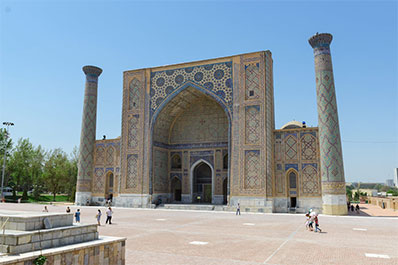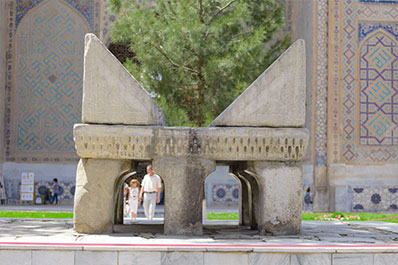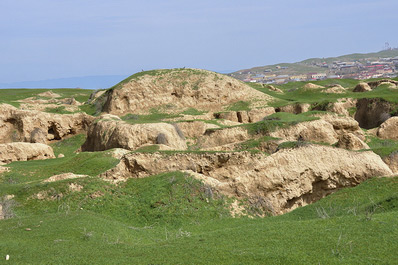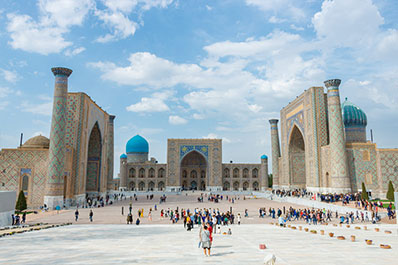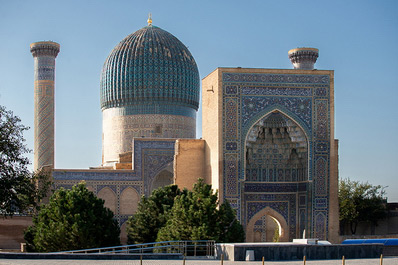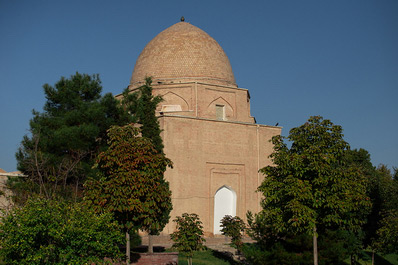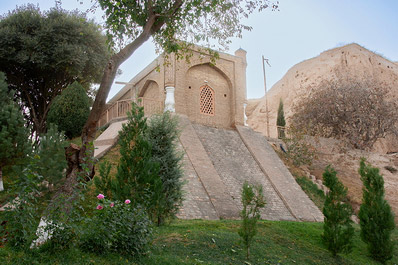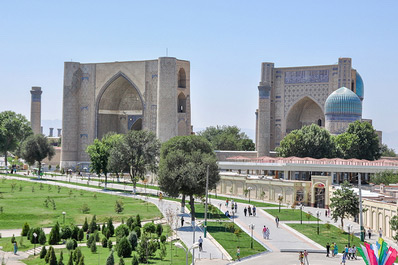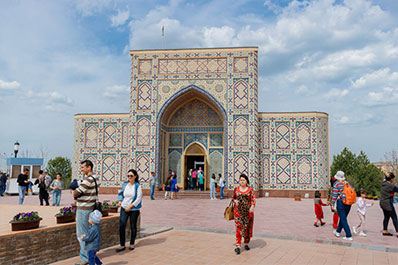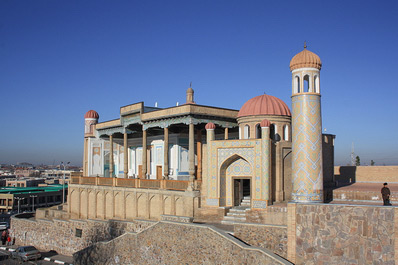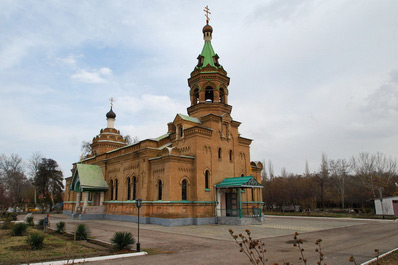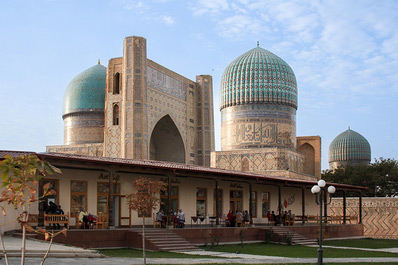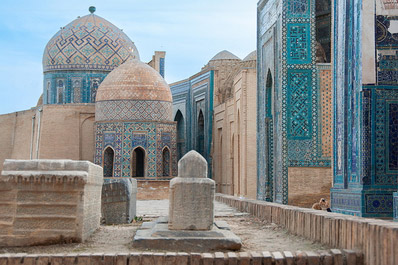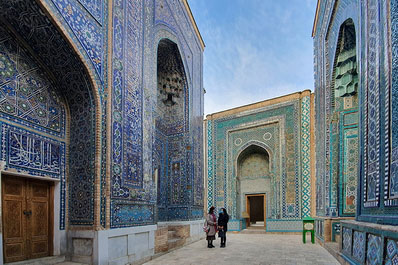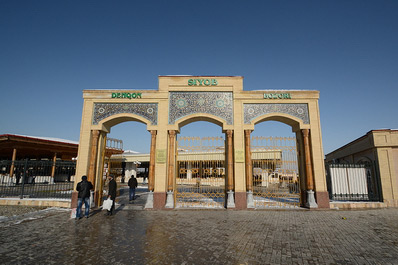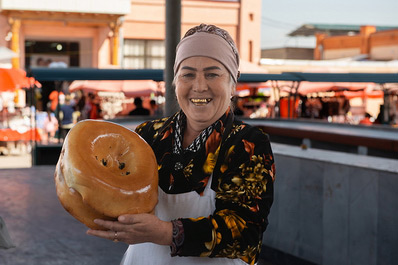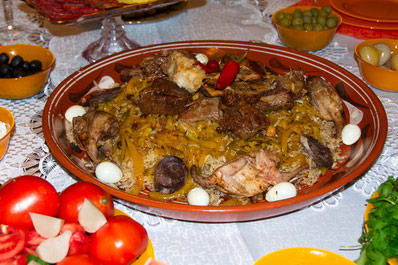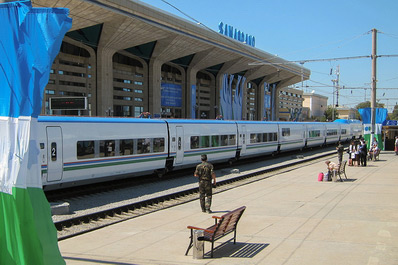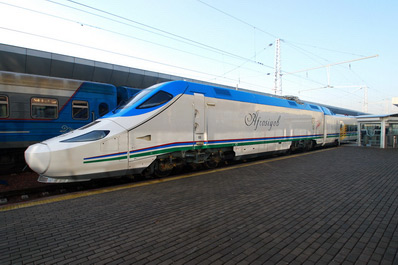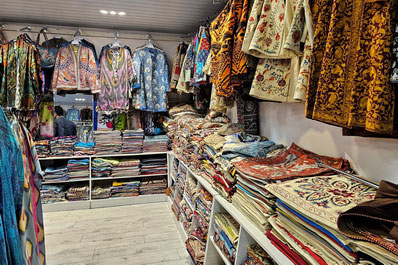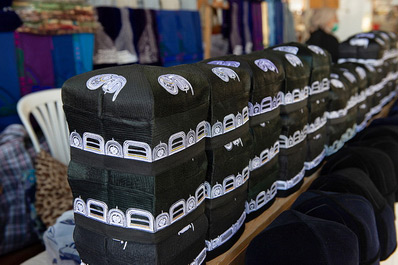Samarkand, Uzbekistan
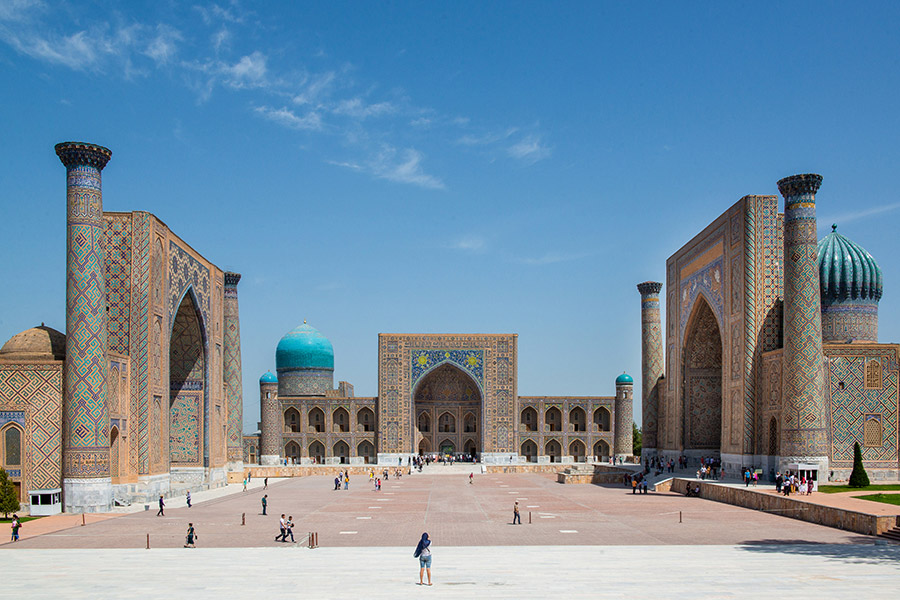
Former names: Marakanda
Elevation: 720 m
Official language: Uzbek
Population: 573,200 (2023)
Time zone: UTC+5
Phone code: +998 66
Zip code: 1401XX
Automobile codes: 30-39
Samarkand is insanely ancient, ranking as one of the oldest cities in both Uzbekistan and the world, with its founding dating way back to the 8th century BC. Back in the day, camel caravans loaded with goods would trek through Samarkand on the legendary Great Silk Road. The city basked in its glory as a capital for ages, a status it held since the times of Amir Timur, only losing it in the early 20th century.
Nowadays, hundreds of thousands of tourists flock to Samarkand, and the city's airport is bustling with guests daily. In 2001, Samarkand made its mark on the UNESCO World Heritage List. Places like Registan Square with its trio of madrasahs, Amir Timur’s tomb at Gur-Emir, Shahi-Zinda (literally "the city of the dead"), the Bibi-Khanim Mosque, Prophet Daniel's mausoleum, and the Ulugbek Observatory are tourist favorites. And let’s not forget the allure of Uzbek cuisine and the unique finds in local handicraft workshops.
You could blitz through the main attractions in a day, but trust, you'd be doing yourself a disservice. Give it at least two days to really soak it all in. And no worries about finding a place to crash; there’s everything from cozy guest houses to swanky 5-star hotels.
If you're up for a bit of exploring around Samarkand, hit up Urgut with its thousand-year-old trees chinaras and the Hazrat Daud (St. David) cave. Or, make a trip to Penjikent in Tajikistan and check out the Seven Lakes.
How to Get to Samarkand?
Hands down, flying is the way to go for getting to Samarkand. Regular flights connect the city to major hubs like Tashkent, Moscow, and even international spots like Dubai and Istanbul. For a scenic route, hop on the "Afrosiab" train from Tashkent; you'll be in Samarkand in under 2.5 hours, cruising through Uzbekistan’s landscapes. Trains also run from Bukhara, Khiva, and other cities. Of course, buses and cabs are options too if you’re starting from somewhere else in Uzbekistan.
Is Samarkand Safe?
Samarkand is pretty much as safe as it gets in Uzbekistan. There are plenty of law enforcement officers around, and you can feel secure wandering the city at any hour, even solo. Just a heads-up though, keep an eye on your belongings and important documents, just to be on the safe side.
Brief History of Samarkand
Celebrating its 2750th anniversary back in 2007, under the guidance of UNESCO, Samarkand's rich history has been confirmed through numerous archaeological findings. The story begins with Afrosiab, a settlement dating back to the 8th century BC, which later became Samarkand. This ancient site remained nameless until the 17th century when it was named after the Turanian king Afrasiab from Iranian mythology.
Breaking down the name, "Samarkand" in Sogdian translates to "stone city," combining "asmara" (rock or stone) with "kand" (city or fortification). While some researchers believed the city's name meant "fat, rich city," others argued it was named after a man named Samar or a spring sharing the same name.
In 329 BC, Alexander the Great’s armies took over, with Greek historians noting that even back then, Samarkand was a city of development. From the 4th to the 8th century, the region, including its capital Samarkand, was under various rulers, including the Hionites, Kidarites, Eftalites, and representatives of the Turkic and West Turkic Khaganates.
Islam made its way to Samarkand in 712 with the arrival of the Arabs, and by the 9th century, the city became the central hub for the Samanids. Fast forward to the early 11th century, it turned into the capital of the Karakhanid state. The Khorezmshahs followed suit two centuries later, also declaring it their capital.
However, the 13th century brought devastation as Genghis Khan’s forces invaded, resulting in widespread destruction and loss of life. The inhabitants eventually moved, building a new city nearby, leaving Afrasiab as an abandoned site which later became an archaeological goldmine in the 20th century.
The era of the Timurid Empire, spanning from 1370 to 1499, marked a time of prosperity and architectural brilliance, with many structures from this period still standing today. Following the Timurid rule, the Sheibanids took over in 1501, and by 1602, the Ashtarkhanids were in control. The 18th century saw the rise of the Mangyt dynasty, and by the mid-19th century, Samarkand fell under the Russian Empire.
Post-1917, the city transformed into a Soviet hub, even briefly serving as the capital of the Uzbek SSR from 1925 to 1930. A notable moment in history occurred in June 1941, when archaeological excavations at Amir Timur's tomb began, inadvertently aligning with a local legend that claimed war would start when his tomb was opened. Just days later, Germany attacked the Soviet Union.
Islam Karimov, the first president of Uzbekistan, originally from Samarkand, was laid to rest here in 2016.
Samarkand Sights & Attractions
Afrasiab, the ancient heart of Samarkand, offers a glimpse into the city’s past, with its ruins dating back to the 8th century BC. Here, archaeologists have unearthed remnants of defensive walls, residential areas, streets, pottery, glassware, and metal jewelry.
Registan Square, possibly Samarkand’s most iconic landmark, is a must-visit, known for its three stunning madrasahs. The square’s first madrasah, Ulugbek Madrasah, dates back to the 15th century, followed by the Sherdor Madrasah in 1636, and the Tillya-Kari Madrasah in 1660.
Adjacent to Registan Square is the Sheibanid family tomb (dakhma), dating back to 1504, now recognized as a part of Uzbekistan’s cultural heritage.
Gur-Emir, the mausoleum of Amir Timur, originally intended for his grandson, ended up as Timur's final resting place, transforming into a family tomb for the Timurids over time. Nearby, the unassuming Ruhabad mausoleum stands, dating back to the 14th century, built by Amir Timur himself, and housing the remains of Sheikh Burhaneddin Klych Sagardzhi.
People from various religious backgrounds, including Islam, Judaism, and Christianity, regularly visit the mausoleum of Khoja Doniyer, also known as Prophet Daniel. It's believed that this site houses the relics of this Old Testament figure. Legend has it that back in the 15th century, Amir Timur brought the prophet’s hand (and possibly other remains) to Samarkand from the city of Suzah. The story goes that the horse carrying these sacred relics stopped by the Siab river, struck its hoof on the ground, and miraculously, a spring burst forth. Timur took this as a divine sign and decided to reinter the relics at this spot (though there’s an alternate tale that suggests someone else entirely might be buried in the mausoleum). Around the same time, a modest mosque was also built on the site. The locals soon caught wind of the miraculous spring, believing its waters had healing properties, and it didn’t take long for the site to gain a reputation as a holy place.
The Bibi-Khanim Mosque, once a grand cathedral mosque in Samarkand, could accommodate up to 10,000 worshippers in its courtyard. Constructed in the early 15th century, it was named Masjidi jami, though most people today know it as Bibi-Khanum, in honor of Amir Timur’s chief wife, Sarai-mulk khanim. Legend has it that the ruler’s wife commissioned this grand mosque as a gift to her husband, placing it right across from the Bibi-khanim madrassah, which she funded. However, Tamerlan wasn’t thrilled with the new mosque as it was shorter than the madrassah. Another version of the story suggests that Amir Timur himself built the mosque for his wife.
Not far from Samarkand, the Khoja Ahrar ensemble includes the 15th-century tomb of Khoja Ahrar, two mosques, and two madrasahs. Muslims flock daily to the site of this saint’s death, a man famed for his visions of the Prophet Muhammad and Jesus Christ, which led him to become a dervish.
Only a section of the sextant and a room plan remain from Ulugbek's observatory, founded in 1420. In its heyday, this observatory was renowned worldwide, and it was here that the most comprehensive star catalog of the time, the Gurgan zij, was created.
The Khazret-Khyzr Mosque, built at the turn of the 19th and 20th centuries on the site of an older mosque, is notable as the burial site of Islam Karimov, the first president of Uzbekistan. Locals say that up to 2000 people were involved in constructing his tomb.
Samarkand's Pokrovsky Church, completed in 1903, is the oldest functioning Orthodox church in the city. Some believe it was the only church in Uzbekistan to escape seizure by the Renovationists during the Soviet era, though others contend that this distinction actually belongs to St. George's Church.
Samarkand also houses another pre-revolutionary cathedral, one of only two in Uzbekistan. The other is the Cathedral of the Assumption of the Blessed Virgin Mary in Tashkent, while Samarkand is home to the Cathedral of St. Alexis, Metropolitan of Moscow. Erected in 1912, the Samarkand cathedral was closed by Soviet authorities a few years later but was reconsecrated in 1996 by His Holiness Patriarch Alexy II of Moscow and All Russia.
Shahi-Zinda, a complex of mausoleums from the 14th and 15th centuries, is a close second to Registan as Samarkand's most photographed site. Each tomb in this "city of the dead" is adorned with mosaic tiles, predominantly in shades of blue and turquoise, and the complex also features its own streets and a mosque.
Visitors to Samarkand also enjoy touring the silk carpet factory, the Samarkand paper factory, and the Khovrenko and Bagizagan wineries, where they can sample the local wines.
Samarkand Museums
Samarkand is home to 13 museums, with the Mirzo Ulugbek Museum at the observatory and the Museum of the Founding of Samarkand at Afrosiab being particularly popular among visitors. Other notable museums include the State Museum of Cultural History of Uzbekistan, the Samarkand Regional Museum of Local Lore, the Museum of Friendship of Peoples and Religious Tolerance, the Museum of Memory of the Victims of Repressions, and the 19th-century student cell exhibition in the Sherdor Madrasah.
Biography enthusiasts will appreciate the memorial house-museums of Sadriddin Aini, Khoja Abdulaziz Abdurasulov, Mahmudkhoji Behbudi, Dmitry Filatov at the Khovrenko winery, and Sayyid Rizo Alizadeh.
Samarkand Theaters
In Samarkand, you've got four theaters showcasing a variety of classical and Uzbek performances.
At the Hamid Alimjan Regional Theater of Music and Drama, they're serving up productions in Uzbek, including hits like "Mirzo Ulugbek," "Samari," "Mashrab," "Imon," and more.
The Chekhov Regional Russian Drama Theater is your go-to for plays like "Farhad and Shirin," "Cry of the Steppes," and "Five Wives of Nasreddin." They've even got a lineup of children’s shows, featuring favorites like "The Cockerel in Cowshoes" and "The Magic Sword."
Don’t miss out on El merosi, the historical costume theater – it’s the only one of its kind in Central Asia! Their performances are dance-based, offering a visual feast of vibrant shows and meticulously crafted costumes in traditional styles.
Samarkand Bazaars
Siab Bazaar is the oldest and most popular market in town, located right next to the Bibi-Khanum mosque. Dating back to the 8th century, this bustling marketplace is a haven for fresh produce, nuts, dried fruits, souvenirs, clothing, and a taste of local cuisine.
The market near the Samarkand railway station is another hotspot, perfect for picking up souvenirs, clothes, and some delicious Samarkand treats.
Samarkand Food
Samarkand is home to a unique pilaf that's a must-try. Made with long grain rice, heaps of yellow carrots, and cooked in zigir-yog (a type of brown linseed or sesame oil), it’s a layered dish that’s never stirred while cooking. Sometimes, it's served with quail on the side.
Indulge in the city's generous kebabs, available in various types and sizes, and don’t forget to try the famous Samarkand flatbreads – especially the patyr, a local favorite with a story to tell.
Transportation in Samarkand
Getting around is a breeze with buses, electric buses, and shuttle buses. Plus, Samarkand is unique in Uzbekistan for its streetcars. After a hiatus since 1973, trams made a comeback in 2017, with routes connecting the railway station to Siab Bazaar and the Sattepo residential area.
Shopping in Samarkand
For the best flatbreads in town, head to "Ulugbek" near the Mirzo Ulugbek Observatory. Try the hearty patyr and light, puffed flatbreads with onions. Don’t miss out on the city’s famous halva, available at Siab bazaar or shopping malls near the railway station.
Samarkand embroidery is a treasure worth taking home, with hand-stitched suzanes being particularly sought after. For a splurge, consider a genuine silk Samarkand carpet, and keep an eye out for handcrafted jewelry showcasing national motifs. The Samarkand Handicrafts Center is a great place to start.
For wine enthusiasts, sample local favorites like Gulakandoz, Farhod, Bayan Shirey, and Aleatico. And don’t forget to take home some handmade Samarkand paper.
Best Time to Visit
Samarkand is a stunner year-round, but the prime time to visit is from March to June or from late August to mid-November. The summers are warm, but do keep in mind that midday sun can be intense, so it’s best to stay indoors from 11:00 to 15:00 during those hot hours.


